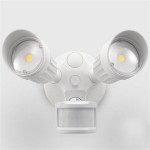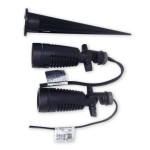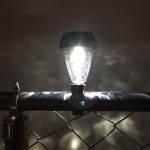Replacement Motion Sensor For Outdoor LED Lights
Outdoor LED lights with motion sensors provide a practical and energy-efficient solution for illuminating pathways, driveways, and other exterior areas. A motion sensor detects movement and automatically activates the light, offering added security and convenience. However, motion sensors, like any electronic component, can fail over time due to environmental factors, wear and tear, or electrical issues. When a motion sensor malfunctions, replacing it becomes necessary to restore the intended functionality of the outdoor lighting system.
Replacing a motion sensor in an outdoor LED light fixture involves several steps, including identifying the type of sensor, choosing a compatible replacement, safely disconnecting the electrical supply, removing the old sensor, wiring the new sensor, and testing the functionality. The process necessitates a basic understanding of electrical wiring and safety precautions. A detailed understanding of these steps ensures a successful and safe replacement, thus extending the lifespan and utility of the outdoor LED lighting system.
This discussion delves into the procedures and considerations involved in replacing motion sensors for outdoor LED lights. It emphasizes safety protocols, compatibility factors, wiring connections, and troubleshooting tips. Furthermore, it addresses common problems encountered during the replacement process and provides guidance on selecting a suitable replacement sensor.
Identifying the Type of Motion Sensor
Before initiating the replacement process, it is crucial to identify the type of motion sensor currently installed in the outdoor LED light. Motion sensors are broadly classified into two main categories: passive infrared (PIR) sensors and microwave sensors. PIR sensors detect changes in infrared radiation caused by moving objects emitting heat. Microwave sensors, on the other hand, emit microwave signals and detect changes in the reflected signal caused by movement. Understanding the type of sensor is essential for selecting a compatible replacement.
PIR sensors are the more common type found in residential outdoor lighting applications. They are generally less expensive and more energy-efficient than microwave sensors. PIR sensors are also less prone to false triggering caused by environmental factors such as rain or wind. However, PIR sensors have a limited range and can be affected by obstructions blocking their field of view.
Microwave sensors offer a wider detection range and are less susceptible to obstructions compared to PIR sensors. They can detect movement through walls and other non-metallic materials. However, microwave sensors are more expensive and consume more power than PIR sensors. They are also more prone to false triggering caused by environmental factors and interference from other electronic devices.
The type of sensor can often be identified by visually inspecting the sensor unit. PIR sensors typically have a lens-shaped cover, while microwave sensors may have a flat or slightly curved cover. The manufacturer's specifications or the model number of the light fixture can also provide information about the sensor type. Identifying the sensor type ensures the appropriate replacement unit is purchased.
Choosing a Compatible Replacement Sensor
Selecting a compatible replacement sensor is vital for ensuring proper functionality and preventing damage to the LED light fixture. Several factors need consideration when choosing a replacement motion sensor, including the voltage rating, wiring configuration, detection range, and sensitivity settings. Purchasing a sensor with incompatible specifications can lead to malfunctions or even electrical hazards.
The voltage rating of the replacement sensor must match the voltage of the LED light fixture. Most residential outdoor LED lights operate on 120 volts AC. Using a sensor with a different voltage rating can damage the sensor or the light fixture. The voltage rating is usually indicated on the sensor unit or in the manufacturer's specifications.
The wiring configuration of the replacement sensor should match the wiring configuration of the existing sensor. Motion sensors typically have three wires: a hot wire (usually black), a neutral wire (usually white), and a load wire (usually red or blue). The wiring connections must be made correctly to ensure the sensor functions properly. A wiring diagram is typically provided with the replacement sensor to guide the wiring connections.
The detection range and sensitivity settings of the replacement sensor should be appropriate for the intended application. The detection range determines how far the sensor can detect movement. The sensitivity settings allow adjustment of the sensor's responsiveness to movement. A sensor with a long detection range may be suitable for a large area, while a sensor with adjustable sensitivity settings can be fine-tuned to minimize false triggering.
When selecting a replacement sensor, it is advisable to choose a reputable brand known for quality and reliability. Reading online reviews and comparing specifications from different manufacturers can help make an informed decision. Purchasing from a trusted supplier ensures the product meets the stated specifications and is backed by a warranty.
Step-by-Step Replacement Procedure
Replacing a motion sensor in an outdoor LED light fixture requires careful attention to detail and adherence to safety protocols. The following step-by-step procedure provides guidance on safely and effectively replacing a motion sensor:
1. Disconnect the Power Supply: Before starting any electrical work, it is essential to disconnect the power supply to the light fixture at the circuit breaker. This prevents electric shock and ensures safety throughout the replacement process. Verify the power is off using a non-contact voltage tester.
2. Remove the Old Sensor: Once the power is disconnected, carefully remove the old motion sensor from the light fixture. This may involve unscrewing fasteners, removing a cover, or disconnecting the sensor unit from the fixture housing. Note the wiring connections before disconnecting the wires.
3. Disconnect the Wires: Disconnect the wires connected to the old sensor. Use wire strippers to strip a small amount of insulation from the ends of the wires if necessary. Identify each wire by color (black, white, and red or blue) and its corresponding connection point on the sensor.
4. Connect the New Sensor: Connect the wires to the new motion sensor, matching the wire colors and connection points according to the wiring diagram provided with the sensor. Use wire connectors or wire nuts to securely join the wires. Ensure the connections are tight and secure.
5. Mount the New Sensor: Mount the new motion sensor onto the light fixture, ensuring it is securely attached and properly aligned. Replace any covers or fasteners that were removed during the removal process.
6. Restore the Power Supply: After the new sensor is installed and all connections are secure, restore the power supply to the light fixture at the circuit breaker.
7. Test the Functionality: Test the functionality of the new motion sensor by walking within its detection range. The light should activate automatically when motion is detected. Adjust the sensitivity and time settings as needed to achieve the desired performance.
Troubleshooting Common Problems
During the motion sensor replacement process, several common problems may arise. Troubleshooting these issues effectively can ensure a successful replacement and optimal performance of the outdoor LED light. Some typical problems include false triggering, no detection, and flickering lights.
False Triggering: False triggering occurs when the motion sensor activates the light without any apparent movement. This can be caused by environmental factors such as wind, rain, or moving objects like trees or bushes. Adjusting the sensitivity settings of the sensor can often resolve this issue. Repositioning the sensor to avoid direct exposure to wind or other potential sources of false triggers can also help.
No Detection: No detection occurs when the motion sensor fails to activate the light despite movement within its detection range. This can be caused by a faulty sensor, incorrect wiring, or an obstruction blocking the sensor's field of view. Check the wiring connections to ensure they are secure and correctly matched. Verify that there are no obstructions blocking the sensor's view. If the sensor is faulty, it may need replacement.
Flickering Lights: Flickering lights can be caused by a loose wiring connection or a malfunctioning sensor. Check all wiring connections to ensure they are tight and secure. If the flickering persists, the sensor may be faulty and require replacement. It is also possible that the LED light itself is failing, requiring replacement of the entire fixture.
Addressing these common problems systematically can help identify the root cause of the issue and implement the appropriate solution. Consulting a qualified electrician may be necessary for more complex troubleshooting or electrical repairs.
In conclusion, replacing a motion sensor in an outdoor LED light involves careful planning and execution. By understanding the type of sensor, selecting a compatible replacement, following the step-by-step procedure, and troubleshooting common problems, a homeowner can successfully restore the functionality of their outdoor lighting system. Safe work practices and adherence to electrical codes are paramount throughout the replacement process.

Motion Sensor Replacement Outdoor Pir Detector Led For Loads Light Com

Commercial Electric 270 Degree White Motion Activated Wired Outdoor 1 Head Dusk To Dawn Security Flood Light Sensor Ce 2701 Wh The Home Depot

Motion Sensor Replacement 180 Degree Led Light For Loads Outdoor Com

Motion Sensor Replacement 180 Degree Pir Detector Light For Led Flood Outdoor Com

Defiant 270 Degrees White Replacement Motion Sensor For Led Cfl And Incandescent Lights Rs 2701 Wh The Home Depot

Lumenology Indoor Outdoor 148 Lumens Battery Powered Portable Led Motion Sensing Ip43 Flood And Security Light Black Lmlogy Smsl 001 The Home Depot

A Short Guide To Fixing And Replacing Faulty Motion Sensor Lights

Didiseaon Hs220 Sensor Light Motion Outdoor Smart Ir Replacement On Off For Controller Pir Led Detector Yahoo Ping

Utilitech 240 Degree White Wire In Replacement Motion Sensor And Light The Adapters Department At Com
Related Posts







